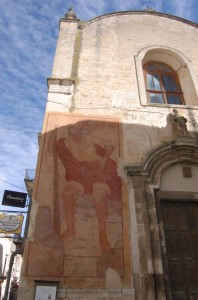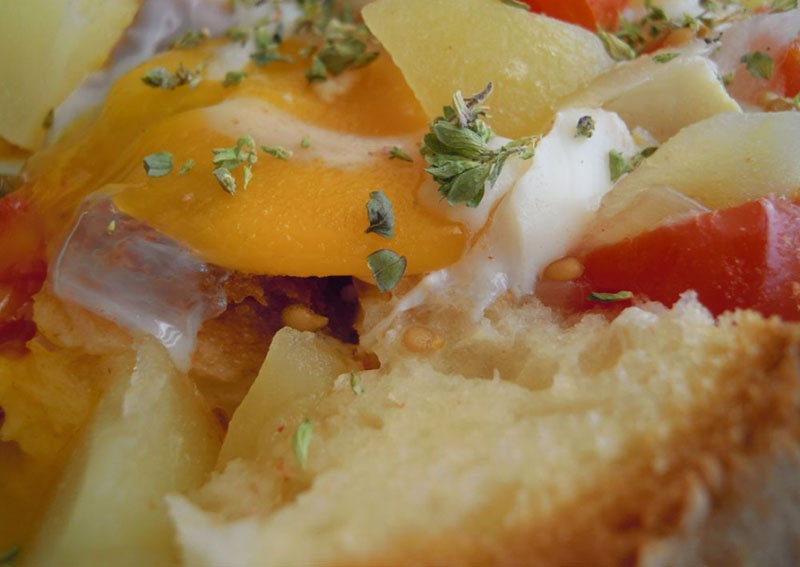PALAZZO VITI – DE ANGELIS
 This is perhaps the oldest palazzo of Altamura, and surely one of the most beautiful. It was probably built in the XV century on a preexisting structure by the will of the feudal lord prince Raimondello Orsini del Balzo. It is adjacent to the most prominent remains of medieval walls and Porta Bari, the only city gate preserved in its former aspect. The extensive three-story building comprises a palace chapel and the wonderful inner courtyard is paved with limestone slabs. A staircase leads up to a turret with Neo-Gothic battlements. Notable are the sumptuous Renaissance portal and the loggia with elegant columns and capitals. One of these capitals exhibits the coat of arms of the De Angelis family that acquired the building immediately after the Del Balzo family and before the Viti family. The latter are still the owners of the palazzo.
This is perhaps the oldest palazzo of Altamura, and surely one of the most beautiful. It was probably built in the XV century on a preexisting structure by the will of the feudal lord prince Raimondello Orsini del Balzo. It is adjacent to the most prominent remains of medieval walls and Porta Bari, the only city gate preserved in its former aspect. The extensive three-story building comprises a palace chapel and the wonderful inner courtyard is paved with limestone slabs. A staircase leads up to a turret with Neo-Gothic battlements. Notable are the sumptuous Renaissance portal and the loggia with elegant columns and capitals. One of these capitals exhibits the coat of arms of the De Angelis family that acquired the building immediately after the Del Balzo family and before the Viti family. The latter are still the owners of the palazzo.
PALAZZO MELODIA
 The palazzo is located in front of the cathedral and overlooks the cathedral square. It was built in the mid-nineteenth century according to the drawings of architect and engineer Orazio Lerario. It is a building in pure neoclassical style. The lower floor counts twelve tall columns, which support a large balcony with ten windows. Always owned by the noble Melodia family, in the early years of the XX century it was bought by the farmer Giuseppe Incampo.
The palazzo is located in front of the cathedral and overlooks the cathedral square. It was built in the mid-nineteenth century according to the drawings of architect and engineer Orazio Lerario. It is a building in pure neoclassical style. The lower floor counts twelve tall columns, which support a large balcony with ten windows. Always owned by the noble Melodia family, in the early years of the XX century it was bought by the farmer Giuseppe Incampo.
BIRTH HOUSE OF SAVERIO MERCADANTE
 Although it looks rather insignificant from the architectural point of view, it is the birth house of the famous Saverio Mercadante (1795), one of the greatest amongst the Italian composers of the XIX century. It is located opposite the church of San Nicola dei Greci and overlooks Corso Federico II.
Although it looks rather insignificant from the architectural point of view, it is the birth house of the famous Saverio Mercadante (1795), one of the greatest amongst the Italian composers of the XIX century. It is located opposite the church of San Nicola dei Greci and overlooks Corso Federico II.
PALAZZO BALDASSARRE
 The palazzo is situated in proximity to Piazza Foggiali and opens onto Via Fratelli Baldassarre. It is a three-story building dating back to the XV century which was almost completely rebuilt in the XVII century. This architectural masterpiece shows many details of artistic importance, such as the wrought iron balcony in Baroque style. It was owned by the eponymous family, having become with time the city’s most eminent family of constructors. The two brothers Michele and Giuseppe are still remembered for their important role in the resistance shown against the siege of Cardinal Ruffo’s troops, in 1799.
The palazzo is situated in proximity to Piazza Foggiali and opens onto Via Fratelli Baldassarre. It is a three-story building dating back to the XV century which was almost completely rebuilt in the XVII century. This architectural masterpiece shows many details of artistic importance, such as the wrought iron balcony in Baroque style. It was owned by the eponymous family, having become with time the city’s most eminent family of constructors. The two brothers Michele and Giuseppe are still remembered for their important role in the resistance shown against the siege of Cardinal Ruffo’s troops, in 1799.
PALAZZO VESCOVILE (FORMER UNIVERSITY BUILDING)
 Leaning against the Arch of the Cathedral. During the second half of the XVIII century it housed the University of Altamura. As attested by a commemorative plaque affixed to the wall, the Royal University of Altamura was founded in 1748 by a decree of King Charles III. It soon became a thriving cultural center and earned the city the sobriquet “Athens of Apulia.” The University was maintained by the “Monte a Moltiplico fund” (ecclesiastical revenues and savings of the lay confraternities) set up in 1619 to erect the Bishop’s palace, never carried out, and used, therefore, for the University as schools fund. With the end of the revolution of 1799 the university shared the dire fate of the conquered and devastated city. In 1811, after a short phase of Goacchino Murat’s reign, the Royal University was closed for good.
Leaning against the Arch of the Cathedral. During the second half of the XVIII century it housed the University of Altamura. As attested by a commemorative plaque affixed to the wall, the Royal University of Altamura was founded in 1748 by a decree of King Charles III. It soon became a thriving cultural center and earned the city the sobriquet “Athens of Apulia.” The University was maintained by the “Monte a Moltiplico fund” (ecclesiastical revenues and savings of the lay confraternities) set up in 1619 to erect the Bishop’s palace, never carried out, and used, therefore, for the University as schools fund. With the end of the revolution of 1799 the university shared the dire fate of the conquered and devastated city. In 1811, after a short phase of Goacchino Murat’s reign, the Royal University was closed for good.
PALAZZO DE GEMMIS - CAGNAZZI
 This palazzo has a splendid eighteenth-century facade and presents an entrance supported by columns with the coat of arms at the top. The building was the residence of the Cagnazzi family, descendants of Samuel de Samuel (the elder), a Greek nobleman who in 1554 had moved to Altamura from the kingdom of Macedonia. In 1628 a certain Marino Cagnazzi offered Samuel de Samuel (the younger) all of its assets, provided that he would assist him in his old age, add the symbol of a “dog” to his family crest and assumed the name Cagnazzi (De Samuel Cagnazzi) as a second last name. However, those who have brought prestige to the Palace are the two brothers Luca and Giuseppe De Samuel, great representatives of the nobility of Altamura in the late eighteenth century. In 1785 Giuseppe de Samuel, brother of the archdeacon Luigi, married Elisabetta De Gemmis. He bequeathed to his son Ippolito the noble title of the stately building. The heirs of Ippolito and his wife Antoinette Martucci lived in the building throughout the nineteenth century. The recent heirs finally sold the edifice to the Clemente family. Today the palazzo houses the ‘Hotel San Nicola’. The two upper floors have been converted into luxury rooms. The staircase is adorned with a stone artifact depicting St. Nicholas from which the hotel takes its name.
This palazzo has a splendid eighteenth-century facade and presents an entrance supported by columns with the coat of arms at the top. The building was the residence of the Cagnazzi family, descendants of Samuel de Samuel (the elder), a Greek nobleman who in 1554 had moved to Altamura from the kingdom of Macedonia. In 1628 a certain Marino Cagnazzi offered Samuel de Samuel (the younger) all of its assets, provided that he would assist him in his old age, add the symbol of a “dog” to his family crest and assumed the name Cagnazzi (De Samuel Cagnazzi) as a second last name. However, those who have brought prestige to the Palace are the two brothers Luca and Giuseppe De Samuel, great representatives of the nobility of Altamura in the late eighteenth century. In 1785 Giuseppe de Samuel, brother of the archdeacon Luigi, married Elisabetta De Gemmis. He bequeathed to his son Ippolito the noble title of the stately building. The heirs of Ippolito and his wife Antoinette Martucci lived in the building throughout the nineteenth century. The recent heirs finally sold the edifice to the Clemente family. Today the palazzo houses the ‘Hotel San Nicola’. The two upper floors have been converted into luxury rooms. The staircase is adorned with a stone artifact depicting St. Nicholas from which the hotel takes its name.























